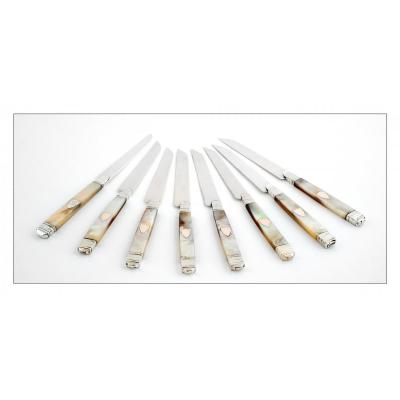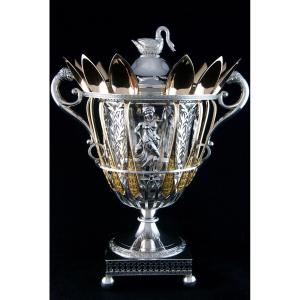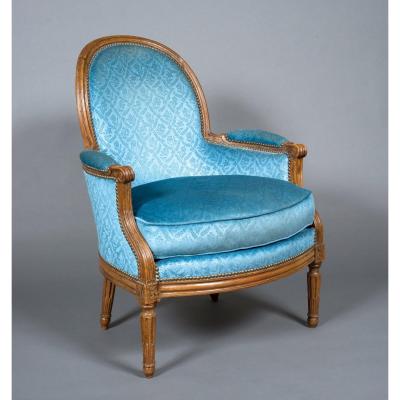Each handle features a different decoration: one in Louis XVI style is adorned with a finely engraved beaded medallion of the monogram "LM" in English letters, topped with a ribbon bow and a laurel wreath. The other handle is decorated with a Lorraine cross intertwined with a thistle, worked in openwork. The basin is plain with a lip.
Hallmarks
• Minerve 1er titre (French mark for 950/1000 solid silver) on each handle and the body.
• Master silversmith: AD in a vertical diamond, unidentified.
Dimensions
• Length: 20 cm.
• Diameter: 13 cm.
• Height: 3.2 cm.
Net Weight: 162 grams.
Condition Report
Very good condition, with a few fine usage scratches. Exceptional quality of craftsmanship.
The Thistle and the Lorraine Cross
Tradition holds that in the 4th century, Helena, the mother of Constantine, the first Christian emperor of Rome, discovered the true cross of Jesus during excavations. Fragments of this cross were then enshrined in reliquaries and attributed to Eastern patriarchs, becoming an official symbol of their divine mission.
From the 10th century onwards, Crusaders returning from the Holy Land began spreading the image of this double-barred cross. It appeared on coins and chivalric insignia. In the 14th century, Duke Louis I of Anjou adopted it into his arms, creating the Anjou cross. However, it was not yet associated with Lorraine at that time.
It was only in 1477, following a decisive battle, that the cross acquired its symbolic role for the region. In December of that year, a harsh winter struck Nancy, which had been besieged for three months by Charles the Bold, Duke of Burgundy. The population, desperate, survived on animals such as horses and dogs. René II, the young Duke of Lorraine, managed to obtain reinforcements from his Swiss and Alsatian allies as well as from King Louis XI, who wanted to end Burgundian dominance. Before the battle, René II distributed white linen Anjou crosses to his soldiers to distinguish them from the Burgundian troops. The victory the following day ended the occupation, reattached Burgundy to France, and strengthened royal authority.
The thistle also emerged as an important symbol of Lorraine. Onopordum acanthium, a spiny plant crowned with purple flowers, was introduced by René d'Anjou and became the ducal emblem after René II's victory at Nancy. This thistle adorns the coat of arms with the Latin motto Non inultus premor ("I am not pressed without punishment"), which evolved over time to become "Qui s’y frotte s’y pique," reflecting the prickly nature of the thistle. This motto is inspired by René II's wife's emblem, a chestnut branch.
In the 16th century, the thistle and its motto were officially adopted as symbols of the city of Nancy.
The thistle and the Lorraine Cross are frequently found in the works of the School of Nancy, whether in ceramics, glassware, wrought iron, or architecture, asserting their presence in modern Lorraine identity.
It is rare to find pieces of antique silverware adorned with these symbols, especially of this quality. The attachment and use of these symbols became particularly vivid during the Annexation of 1871. This cup was likely made to celebrate the union of members of a prominent Nancy family.






































 Le Magazine de PROANTIC
Le Magazine de PROANTIC TRÉSORS Magazine
TRÉSORS Magazine Rivista Artiquariato
Rivista Artiquariato